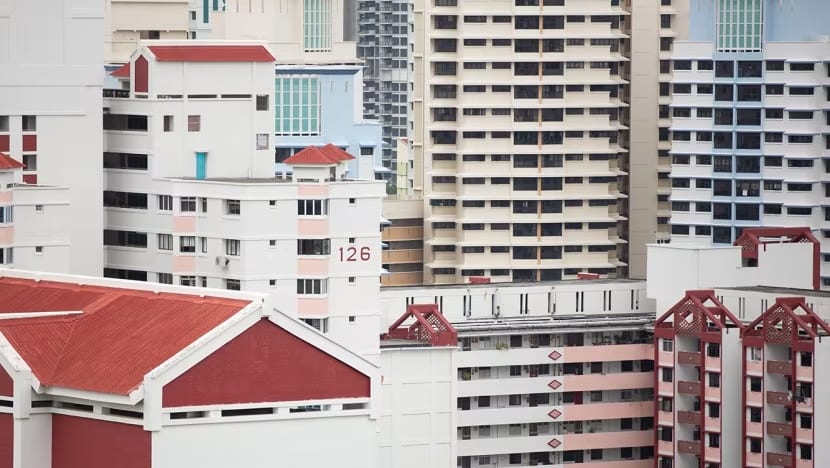New govt unit helped mental health case in Tampines neighbour dispute get hospitalised, treated
Parliament was told that the case was one of the three mental-health related neighbour disputes the Community Relations Unit has handled during its pilot in Tampines town.

A general view of HDB flats in Singapore. (File photo: TODAY)

This audio is generated by an AI tool.
SINGAPORE: A new government unit dealing with neighbour disputes facilitated the inpatient admission and treatment of one of three mental-health related cases it has dealt with since its launch earlier this year.
The Community Relations Unit (CRU) has handled a total of five severe neighbour noise cases escalated by the Housing and Development Board (HDB) and the police since April this year, when it began a one-year pilot in Tampines town.
Giving an update in parliament on the resolution of these cases, Minister of State for National Development Alvin Tan said on Tuesday (Oct 14) that apart from the mental health case receiving treatment, the CRU was conducting "consistent follow-up with the community for the other two".
Another case, not related to mental health and involving the deliberate use of noise to disturb neighbours, has "abated" after joint intervention by CRU, the police and the Town Council, Mr Tan said.
In his reply, Senior Minister of State for Law Murali Pillai noted that an incident in a Yishun housing block last month - that left one woman dead - had Singaporeans understandably concerned.
Koh Ah Hwee, 66, was accused of murdering Nguyen Phuong Tra by stabbing her in the chest with a knife on the morning of Sep 24 outside a sixth-floor unit at Block 323 Yishun Central.
Preliminary investigations revealed that a fight arose from a noise dispute. Mediation had not taken place as Koh did not respond to an invitation for this to occur, the Ministry of Law and MND previously said.
CRU NOT A PANACEA FOR NEIGHBOUR DISPUTES
At Tuesday's sitting, MPs asked for numbers related to neighbour disputes, including how many compulsory Community Mediation Centre (CMC) attendances were directed through the various channels for each of the last three years, and how many cases of disputes between neighbours had escalated to violence resulting in injuries and fatalities.
MP Kenneth Tiong (WP-Aljunied) asked what distinguished a severe noise dispute qualifying for CRU intervention, while MP Abdul Muhaimin Abdul Malik (WP-Sengkang) asked for the total number of cases resolved or closed by the CRU.
Both asked for an assessment on the efficacy of the unit.
The CRU, announced in August last year, can investigate and take action in severe cases of neighbour disputes involving noise and hoarding. It is part of enhancements to the Community Disputes Management Framework (CDMF), which was set up in 2014 to help with neighbour disputes.
Mr Tan said that the CRU framework strikes a balance between the government stepping in to manage a dispute and leaving enough room for neighbours to settle disputes themselves.
"It is not a panacea for neighbour disputes, and is not a substitute for a strong foundation of positive community norms, and also good neighbourly relations and community dispute resolution options," he added.
As part of its investigatory and enforcement powers, the CRU has the ability to deploy noise sensors, however these were not required in the five cases investigated in Tampines.
As a "last resort" after exhausting other levers, the CRU may refer the most severe and recalcitrant nuisance-makers to HDB, to consider compulsory acquisition of their flats, said Mr Tan.
"Overall, the average monthly volume of neighbour disputes feedback in HDB estates across Singapore over the past five years has held steady at about 2,500.
"HDB does not otherwise track the number of disputes between neighbours in HDB flats, or the number of cases that escalated into physical altercations," Mr Tan said.
He later replied to a question by MP Gerald Giam (WP-Aljunied) to say that there have been 160 items of feedback related to neighbour disputes per month in Tampines since April this year.
Mr Murali told parliament that from November 2024 to August 2025, about 1,300 neighbour disputes were registered with the CMC for voluntary mediation.
In about 50 per cent of these cases, one party did not respond. In another 20 per cent of the cases, at least one party declined outright, Mr Murali said.
From 2022 to 2024, the Community Disputes Resolution Tribunals (CDRT) and the Magistrates’ Court referred around 90 and 80 cases respectively to the CMC for court-mandated mediation.
He noted generally that most cases should be addressed through mediation or by the CRU.
For the remaining "intransigent cases", affected residents can consider the CDRT as a last resort, Mr Murali said. The CDRT is a specialised court that hears cases involving neighbour disputes.
In response to MP Elysa Chen (PAP-Bishan-Toa Payoh)'s query about CDRT's caseload, Mr Murali said that the top three categories of CDRT disputes for the last five years were claims for excessive noise, excessive vibration, and littering.
Between 2020 and 2024, a total of 1,031 CDRT claims were filed. About 65 per cent, or two out of three claims, involved excessive noise.
Of these claims, the CDRT issued 233 CDRT orders, and dismissed or struck off 145 cases. Another 651 claims were withdrawn or discontinued.
The CDRT made 26 enforcement orders, comprising 24 special directions and two exclusion orders.
A special direction is a direction by the CDRT to a party to comply with an order made against them within a specified time.
If the party fails to comply, they may be guilty of an offence and jailed or fined.
An exclusion order is a court order for a party to be kept out of their residence. If the party fails to comply with the exclusion order, he or she may be guilty of an offence and may be fined or jailed.
The average monthly volume of neighbour disputes feedback in HDB estates over the past five years has held steady - at about 2,500. Minister of State for National Development Alvin Tan, who gave this update in reply to MPs’ questions in parliament on Tuesday (Oct 14), stressed the need for strong community bonds and norms so that fewer disputes will arise. But where they do arise, the parties involved are more likely to resolve their differences in an amicable and mutually acceptable manner if norms and practices are strong, he added. He said this is an outcome worth working towards as a "we first" society. Mr Tan highlighted the Community Relations Unit framework being piloted in Tampines as a useful complementary tool. He said the government is reviewing this pilot carefully to ensure that its systems and processes are effective, as well as resourced correctly and sustainably before extending it to other towns.
PERCEPTION THAT CDRT IS TOOTHLESS
In his supplementary questions, Mr Tiong asked if an MP would not be considered a "sufficient gatekeeper" for compulsory mediation for residents who have appealed and have written letters through their MP.
In response, Mr Murali said that an MP usually heard "one side of the story".
"It's very difficult to hear both sides of (the) stories, but the public officers are able to do so.
"At the judiciary level ... the judges have discretion to order directions as well. So cumulatively, we are able to deal with this matter, ensuring that mediation is really the main thrust of our approach or strategy to deal with neighbours' disputes."
Mr Tiong also asked how residents outside of Tampines should appeal for compulsory mediation. Mr Murali said the government hope to explore this through the pilot.
"We are looking to complete the pilot, learn ... from the issues ... and then we certainly want to extend it to all parts of Singapore," Mr Murali said.
Mr Tiong then commented that there was a "widespread perception that the CDRT is quite toothless", because even if a party obtained an injunction, getting an enforcement order seemed to be "quite difficult".
In response, Mr Murali pointed to the legislative framework, which allowed a person who breaches a special direction to be prosecuted and convicted.
"That must mean that there is some tooth to the action. It's really a matter of enforcement," Mr Murali said.
He added that under the enhanced powers visited with the CDRT, the HDB can evict a person from his or her flat.
"In fact, there have been instances where respondents have been ordered to leave their homes for period of 10 days and 14 days. So these measures, are certainly measures with serious outcomes."
Among his queries to Mr Tan, Mr Tiong asked what "unique capability" did CRU add beyond the HDB and the police, which could already mediate and investigate neighbour disputes.
Mr Tan then stood to ask Mr Tiong if he could "100 per cent guarantee that any of these suite of measures, including the CRU, can deescalate a neighbour dispute".
Noting that this was a "strange question", Mr Tiong replied: "Clearly, I think you cannot 100 per cent guarantee deescalation, but it would make sense at the margins."
Mr Tan continued that no measure had a "100 per cent guarantee".
"There is no special power that the CRU has. And so let's exercise reason ... and recognise that there is no tool that is perfect and recognise that we have a useful suite of tools that are available to us thanks to the enhanced CDMF.''
He added that the CRU was an intermediation in the middle between voluntary mediation and enforcement.
















